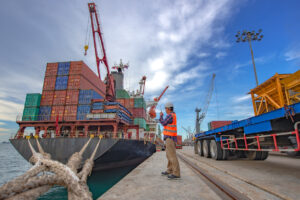The Philippine Maritime Industry Authority is confident that the deployment of Filipino seafarers is returning to pre-pandemic level.
By Liz Lagniton, Philippine correspondent, Maritime Fairtrade
More than a quarter of the world’s 1.6 million seafarers serving on international merchant ships come from the Philippines, but the Covid-19 pandemic hit hard not only on individual incomes but the country’s economy as well.
In 2020, the Philippine Overseas Employment Administration (POEA) said that the number of seafarers deployed abroad went down at the onset of the pandemic because of travel restrictions.
But the Philippine Maritime Industry Authority (MARINA) said the total number of sea-based workers going abroad this year are gradually returning to pre-pandemic levels following an increase in May.
“We are now in a pre-pandemic approach because our monthly deployment has reached 30,000 (seafarers) in May this year. So, we’re moving forward because there is an increase in numbers in terms of deployment,” MARINA administrator Robert Empedrad told Maritime Fairtrade in an interview.

Global demand for Filipino sailors still high
While Covid-19 has slowed down the deployment of seafarers abroad, Empedrad said Filipino seafarers are still in high demand among foreign shipowners.
“I think the demand for our seafarers did not dwindle. We are still number one, the first choice (when it comes to hiring crew members). Our seafarers are still sought after by foreign ship owners. And now, deployment is slowly returning to pre-pandemic levels, and this is good,” Empedrad said.
Citing data from POEA, Empedrad said some 40,000 seafarers were deployed abroad before the COVID-19 pandemic.
POEA administrator Bernard Olalia said 30,000 seafarers were deployed last May, twice the 15,000 who were dispatched in January. He said deployments in May were also 10,000 less than the 40,000 sailors sent overseas every month prior to the pandemic.
“On January 21 2021, some 15,000 seafarers were deployed. But in May, the number has doubled as we were able to deploy some 30,000 to different destinations,” Olalia said in an online briefing. He added that the worst was in July 2020 when deployments fell to a record low because of the inability of the Philippines to conduct crew change from March to April.
Fortunately, the Philippine government quickly saw the dire situation and implemented measures to at least maintain the crewing industry’s contribution to the economy. So, schemes such as the special “green lane” for seafarers and crew changes, the opening of more ports, and the reclassification of Filipino seafarers as essential global workers, boosted the deployment, according to Empedrad.
The green lane policy, which was the first in Asia, allows the safe and swift disembarkation and crew change of seafarers in a designated local port. Crew change hubs were eventually opened in 2020 to support seafarers, who are the biggest contributors of dollar remittances to the country, after restrictions emerged to limit coronavirus transmission.

Government is determined to improve deployment
“The deployment is picking up, returning to pre-pandemic. Hopefully, we are going to have 40,000 seafarers for the next deployment, next month, or even this September,” Empedrad said.
In 2019, Filipino seafarers remitted US$6.5 billion to the Philippine economy. But with the pandemic, government data showed a slight drop in remittances from overseas Filipino workers (OFWs), but not as steep as expected since OFWs continued to send money to their families back home.
When asked for an update on crew change policies, Empedrad said: “The crew change is still okay. We continue to allow crew change. But, if the protocol is changed, for instance, when we have high infection rates, and the capital region is under the strictest enhanced community quarantine (ECQ), then there will be no crew changes.”
“Now, I think we are back to normal. No more restrictions. So, we always have protocols that are fixed and will be implemented in particular quarantine procedures. Our crew change will continue, and we provide green lanes for the safety of our seafarers,” he added.
Empedrad said there are still many seafarers who are stranded in their ships with extended contracts due to travel restrictions at airports.
“That’s the problem because there are limits to the number of people who can enter the airport. So, we are asking the airport authority if it is possible to exceed that limit for our returning seafarers. For instance, if the limit is 2,000, then there are additional 50 seafarers coming in, I hope they will allow exceeding the limit,” he said.
Aside from this, many flights were also canceled due to the pandemic, which left many seafarers stuck at sea for months. Some even complained that their bodies were sore because they had to continue working on vessels even though their contracts have already expired.
“If we don’t take care of our seafarers, if we don’t bring them home, the value of our seafarers will decrease, maybe ship owners will get seafarers from other countries. That’s what we are telling them and hopefully, they will listen to the plight of our seafarers.”
More deployments in coming months
With the continued vaccination of Filipino seafarers against COVID-19, Empedrad said the country is on its way to recovering the pre-pandemic level of deployment of seafarers overseas.
Citing India and Indonesia, which grappled with the Delta variant in the past months, Empedrad said the job opportunities transferred to them since last year will be returned to Filipino seafarers.
“Our seafarers are getting vaccinated and our crew change continues with minimum disruptions. So, the number of deployments will further increase in the coming months,” Empedrad concluded.
Image credit: MARINA










